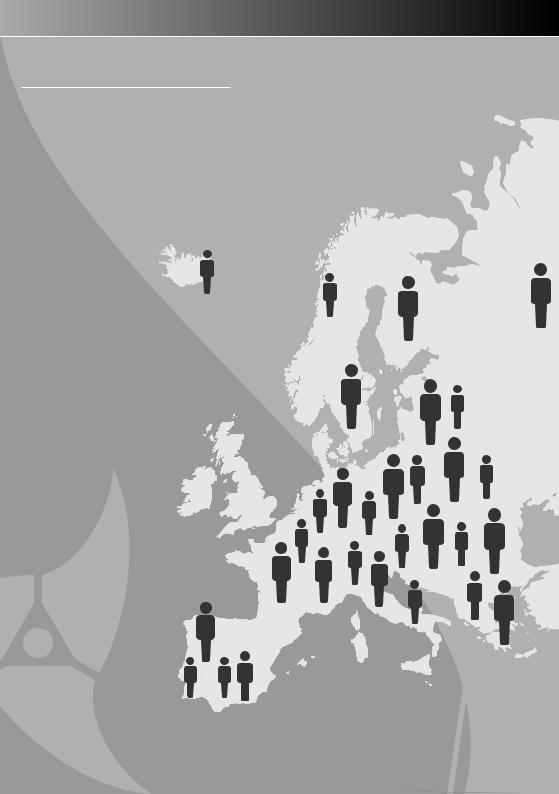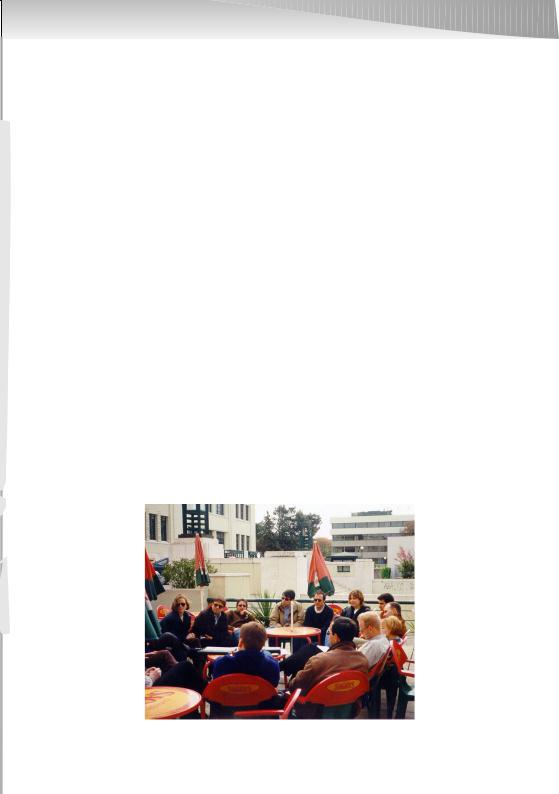
History Book of BEST
.pdf
151
The new management structure created in the WorkShop was voted and implemented in GA 2005 in Greece.
So if before there were 9 boardies (which included the Committee Coordinators as well), the board was now composed of 6 people, and there were also 6 Coordinators outside of the board. With just 6 boardies, the regional boardie idea was no longer sustainable. There would be too many LBGs for each boardie to follow up on.
So one of the boardies “the VP for Internal Communication (as named in the WS)” officially called VP for Local Group Support would coordinate the “regional contact persons”. And so, by adding the regional boardie responsibilities to the RAT, and with coordination from the VP LGS, the Regional Advisors were born.
This way the board stepped back from 2 sets of duties: coordinating the committees and keeping direct contact with the LBGs, therefore being able to focus more on planning and the big picture.
The first generation of RAs was elected through democratic elections (one LBG - one vote) in June-July 2005.
The regions they had to advise were formed after GA 2005 according to what the LBGs wanted. 8 regions were formed, taking into account transportation cost, cultural similarities, visa issues, etc.
Later on, at the first RA Meeting in Chania in March 2006, there were discussions about small changes in the regions, like putting Italy with south France and Greece with Balkans (as previously Italy and Greece were a region). This proposal was approved at GA Zagreb.
As all pioneers in history, the first generation of RAs had the main goal of defining what they are and what they have to do. Close to the end of their mandate, they decided to have the very first Regional Advisors Meeting, in Chania (where they had just been invented less than a year before) They created the first RA Handbook (with tips on how to keep in contact with LBGs, how to solve their problems, how to filter information flow between the 2 level of BEST etc) and also the concept of the Regional Meetings. But defining the position is not the only thing they did there.
Joggling the regions
At the end of the RA Meeting in Chania, they had popped up with several ideas about the new and improved regional division. One of the ideas was to have concentric regions, where central LBGs would be region 1, the first ring around them region 2, and so on until the last region which would contain Trondheim, Reykjavik, Lisbon, Naples, Chania, Istanbul,
Ekaterinburg etc. Although it may sound crazy, there was some reasoning behind this, as the regions would now empower diversity as well, not just make neighbouring LBGs even closer and separated from the others.
In the end, the solution presented had 8 regions, but:
• Skopje and Greek LBGs would be in the same region in the hope of releasing some of the political tension. On short term it created quite a scandal, with some

Chapter 4:
BEST Network
LBGs saying they will leave BEST if this division is done, but on long term it proved to be very effective. Less then one year later, 120 Greeks were singing and dancing together with the organisers in the biggest BEST event ever: Jamboree Skopje 2005.
•Countries with many LBGs (such as Romania, Poland and? well... Paris) were divided into several regions. The point of this was to prevent the national spirit from setting in too deep, and focus on the exchange of experience between LBGs all over
Europe. There was also the issue of language: in one RM in Romania, there were 5 Romanian LBGs represented, one delegate from Istanbul and no one from Sofia.
Needless to say 50 people did not start speaking English for one Turkish guy.
•They also CRASHed CASH. Since this region had mostly former Yugoslavic LBGs that spoke more or less the same language, the Austrians and Hungarians were feeling somewhat isolated. The best solution was to split Yugoslavia (again!) and make a more balanced distribution of languages;
•Nancy and part of Paris went to Lowlands;
•Italians the other French LBGs were now Alpine region;
•Yet some things can never change: and those things are Iberia :p
Well, the second round of RAs was elected in the same democratic fashion one year later.
Well, some more some less democratic, as after several rounds of equal votes for the French and Italian candidates in Alpine, the winner was finally decided according to the result of the
World Football Championship Final.
They decided that the country that loses the Championship gets the RA position as compensation. However their Latin spirit triumphed, and as they could not live with themselves to support the opposing football team, they decided that winner takes it all.
Italy took the Cup and the Region! Many years from now you will still hear Italians shouting:
“Pooo-po-ro-po-po-poo-pooo!!!”
This second generation of RAs did not have a RA Meeting, so at the end of their year, they passed the same regions to their successors. Good for knowledge transfer, but bad for flexibility. One more year after, when the board decided to make some minor adjustments to the regional division, hell broke loose.
South East had now become almost double in size than some of the other regions (with a lot of Turkish and Serbian LBGs joining BEST in a very short time) and it made sense to do something about it. But now, the regional spirit of South East and the sense of belonging of the Central LBGs made it almost impossible to reach a concession. In the end South East became South (8 LBGs) and Central South (6 LBGs). Just as it had happened at the last division, it took about 1 month for hell to cool down and people to stop complaining.
Currently there are 9 regions in BEST, and with the RA Meeting becoming a tradition, more changes are expected.
152

153
We have a region. Now what?
Within this taboo third level of BEST, many things have started to develop.
First of all, some regions didn’t like their geographical name, so they started being creative.
Central Region --> Cream
Iberian --> Portunholes
Nordic --> Nordic Kingdom (imitating Nordic mythology)
South East --> Halara region (Greek term that means relaxed); Flexi region (from the very cheap Balkan Flexi-Pass)
Central South --> Pleskavita region Central East --> Mongolia
North East --> Jamaica (this was more of a forced creativity, since the LBGs in North East wanted to be called Nordic, but were not allowed)
Then, traditions started to emerge:
Mongolia has its very own special drink called the Mongolian (a 500 ml drink with 3 layers: Coke, beer and vodka). There is also a ritual behind consuming this drink: the would-be drinker has to come to a Mongolian and ask for the drink. The Mongolian will shout: “On your knees, bitch!” After kneeling, the drinker will receive a healthy set of slaps over the face, and finally his drink which has to be finished in one sip.
And after the identities of the regions were defined, the projects appeared as well. We now have Regional TrainShops, Joint Board Trainings, Regional JAMs, and more recently Regional
Engineering Competitions.
Article written by Cristian Arteni

History Book of Board of European Students of Technology |
1989-2009 |
Chapter 5
BEST Organisation
• Working Groups
• Committees
• Board
• Honorary members

155
Working Groups
AlumniNet
First ideas related to alumni networks were discussed at GA2002, where the Local Alumni Network WG stressed the importance of preserving the communication and relations between LBGs and their alumni. The idea was embraced by everyone, and not long time after, another great idea popped up: to make a giant European network of BEST alumni.
In 2005, a group of alumni took the initiative in creating the link between all of the alumni of BEST from Almada to Ekaterinburg. The main purpose was to ensure the communication between Alumni, and BEST and Alumni.
So, for coordinating this network, AlumniNet was created. The WG was founded in 2005 by Anna Travesset, Wouter Schaekers, Gregoire Toussaint, Mirjam Zwanenburg and Gabriela Popescu.
For this to be a success a strategy was needed and some responsibilities were created.
Therefore they were thinking about defining some responsibilities that would help the network to grow by focusing on some key points. The main tree responsibles would have to focus on promotion, IT problems and the coordination of the entire network.
One of their main interests was to promote the project so more and more alumni join the network. For this, they needed a common playground; so they focused in implementing an interface on PA. To make it more useful, every alumnus could FB and complete his/her profile in PA. The profile contained personal info, current job/university + job/university history, studies and alumni involvement. After GA Zagreb, at every GM, Alumni Net was taking care of Alumni Meeting and having some discussions how to improve the Alumni Network and the collaboration with active BEST members.
Alumni Meeting at GA Lisbon in 1999

Chapter 5:
BEST Organisation
Only from 2006, after the Alumni Short Intensive Meeting in London, they defined several important projects like: AlumniNet public website, AlumniNet PA pages, AlumniNet Gallery,
AlumniTimes. Gaining in image, alumni network benefited of the support of the International Boards and the number of the alumni joining the network grew more and more. An official alumni mailing list was created where hot topics were discussed. This way, alumni established a simple and good way of communicating with BEST and offering support and FB in different matters.
The first issue of AlumniTimes appeared in June 2006, and it was suppose to be a biannual magazine. Until now, 4 editions were completed and savoured by BEST alumni and members.
The major project of AlumniNet was organizing an event for alumni similar to the BEST courses: BEST Alumni Network Event On Sustainable Energy (BANTSE). For this, there were several presentations made, a schedule and prepared all of the details of the event.
AlumniNet was present at GA 2008 with a presentation of the development of the network and ways to improve the collaboration. Even from the beginning, alumni net caught the attention of many BESTies eyes and the network got affected the snowball effect ....more and more alumni joined and spread the word about it!
Article written by Mirela Andriescu
Competition Working Group
Competition Working Group was the team dealing with Engineering Competitions which have been a real part of BEST since the beginning in 2002. The first real experience of
BESTies with an Engineering Competition (EC) came in March 2002 when some BESTies went to the Canadian Engineering Competition (CEC). They came back very enthusiastic and started to promote the idea for this kind of BEST event. On ICF 2002, GA 2002 and some summer courses in 2002, small team designs and debates were organised.
The board saw that the idea was appreciated a lot and asked David Gonzalez (one of the BESTies who had been on the CEC2002) to create an international working group and to work out the idea in more detail. A call was made in the end of August 2002 to all BESTies and soon an enthusiastic group of BESTies started to create the first EC-Handbook.
In PM 02 this EC-Handbook was presented and Competition Working Group (CWG) was founded in PM 02 with the goal to develop the concept of Engineering Competitions inside BEST. It was decided to let this working group organise the first BEST Engineering
Competition (BEC) (at that time called BEST European Engineering Competition or BEEC) together with an LBG.
LBG Eindhoven and LBG Ghent organised this first B(E)EC together with CWG and it was
156

157
great success and inspiration for the future engineering competitions. After that CWG got requests from several LBGs to organise a BEC together with them. But the board decided to organise also in 2004 only 1 big B(E)EC, to give CWG next to that time to work out a second version of the EC-HB and to work out a scenario how to continue with this project in BEST. The second B(E)EC was organised by LBG Warsaw and CWG with help from baby member Gdansk from 8 till 16 October 2004 in Poland.
CWG successfully coordinated the tasks of the first two BEST European Engineering
Competitions. In PM 04 a new concept was presented and approved. In this new concept for BEST Engineering Competitions the LBG takes care of the complete event, also organising the competition content of the event. This transformed CWG from a task developing working group to a working group keeping the overview over the BEST Engineering Competitions and giving feedback to BEC-organising LBGs. And in the year 2005 3 more BECs took place in spring and summer seasons. After this year, more LBGs organized BEST Engineering Competitions as these were dynamic events, full of challenges that gave the students a practical and new experience.
Article based on the Competitions wiki page
Helpdesk
The BEST Helpdesk team is a group of BEST members belonging to the different committees and working groups of BEST. All bodies of BEST are represented here. They are responsible for answering the requests, questions and doubts submitted through our web-based
Helpdesk system (www.best.eu.org/helpdesk and private.best.eu.org/helpdesk).
Helpdesk was created in 2000 by Gwenael Alizon, from Ecole Centrale and was running on
PHP. Gwen was the first responsible in 2001/2002 and there have been 4 more coordinators since then. After 2003, Helpdesk was running under Makumba.
“The purpose of Helpdesk (HD) is pretty simple. It’s a platform that allows users of our IT systems and people interested in BEST to have contact with the organisation in case they have some problem or question that they cannot solve or they cannot find information on our website. HD was created for having the possibility to track the progress of the requests, so that questions and problems are not lost as time passes by.
There’s not much to say about the evolution, it has been a quite steady group of BESTies taking care of requests and they do the same job since 2001 without many changes. The IT systems are improving, the basis of the work done remains the same.” (Panagiotis Isigonis, LBG Chania)
Article written by Panagiotis Isigonis and Mirela Andriescu

Chapter 5:
BEST Organisation
Knowledge Group (KG)
The Knowledge Group (KanGaroos) has been created at GA France 2007 and is a result of the restructuring of the Training Interested Group.
Its main goal is set as ‘Collect and organize the Knowledge in BEST’. For this, the WorkShop in Paris hosted by LBG Paris Ecole Polytechnique in 2006 was the starting point of the restructure of the knowledge inside BEST.
After GA France in 2007, the decision was final: a new team was to be born to restructure all of the knowledge that BEST accumulated during 18 years of existence. The team consisted in people interested about the knowledge management of BEST but in the same time not necessarily trainers. Before 2007, only TiGro members were taking part in the restructure of knowledge inside BEST.
After 2 years of existence, KG defined several projects that their members are working at: Knowledge Collection, LBG Materials, LBG HandBook, Games Database and History of BEST.
The activity of this WG will never end, thus BEST is in a continuous development but having all of the information structures in a simple way will prevent us in reinventing the wheel over and over again.
Article written by Mirela Andriescu
NewsTeam
NewsTeam is the Working Group supported by markeTeam Committee that is responsible for making BEST events more visible to our stakeholders, by publishing press releases, and establishing media contacts. Also it is responsible for making the BESTtimes editions, which is the official internal magazine of BEST edited & published on digital format.
The BEST magazine was produced before BESTtimes appeared, and now it can be found in the LBG’s offices (no digital versions).
The idea of BESTtimes started in the XV Board, but Tina Toni, secretary in the XVI board was the first one to implement its basis. Then Eva (Secretary of the Flowers Board) took care of it afterward, and improved it by creating something similar to a newspaper, almost a monthly edition.
Then it was managed only by the Secretary and one or two more people. The XVIII had it as well, but less frequent. They also started the international and external newsletter.
As the things started to move, the group had other responsibilities. In 2009 the group takes care of all external and internal news (BESTimes and the news in PA and Public Web Site news), and it is responsible of the contacts that BEST has with the media.
Article written by Ruxanda Burtica and Mirela Andriescu
158

159
International Engineering Competition
This group consists of members from 3 different organisations, more than 30 different nationalities, people with different levels of experience with engineering competitions and different background in their respective organisation.
The group focused on every aspect in organizing this world wide event, and made a vision statement where they decided on the type of competitions, the opportunities provided to students, on the cultural exchange provided for the students. A committee with members from all organizations had to take care of all the organizing details, the contests and the administrative problems.
The international working group of the project met from the 12th to the 14 of October 2007 in Brussels, to discuss and work on the future of the IEC project.
During a productive and fruitful meeting, they created the timeline and decided how to move on. The date for the 1st IEC to take place was fixed but there was still a lot of work to be done to bring IEC in 2010 to life. The following steps were discussed at that meeting. Last but not least, it was planned to have two life meetings per year.
Although it is a very promising event, from where all parties involved have lots to gain, the project is moving on slowly despite the efforts of the members involved.
Article based on the IEC documents
WebTeam
On September 1998 Dionysios Synodinos (Dio), who was, by that time, responsible of the public international web pages of BEST sent a mail to best-int@ (the mailing list that later became lbgs@) asking for the e-mail address of the people taking care of the sites of local groups. The response was great and some weeks later he put all those addresses on webmaster@, the purpose was to create a group of people that would assist him to maintain the international site.
Webmaster group recognized
“This group was recognized after GA Lisbon in 1999. There the Webmaster Group had a couple of places. What I do remember is that, there, a meeting on a new site took place and that a member of the Board attended. In that GA Dio was elected (again) web responsible.” (Dani Buxeres) In the summer of 1999, most of the members of the Webmaster
Group attended a SC in Athens that about Java. There, they had some meetings about the new look of the website in parallel with the activities from the SC.
This group of people didn’t have access to the ftp server where the pages were hosted but had to send the updates to Dio, who uploaded them to the server. After some time, the way

Chapter 5:
BEST Organisation
of working changed and instructions were sent on the ML on how to update the pages on the server by Cristi Bogdan from LBG Timisoara.
At PM in 1999 the Board asked Dani Buxeres to lead the group until the GA had to vote on a new coordinator. So the weeks after he took the responsibility of keeping the site updated (by that time the site was designed in a way that made it need frequent updates).
After some time, a restructure of the group was made :the first things the members did was to clean up the mailing list, remove all the people who were not active at all and mail lbgs@ inviting interested people to join the group. A new group was about to be born. We had at least one person in each position: coding, writing and designing. We also had good contacts with other committees but the group lacked some tradition, structure and the knowledge of how to do things. This structure was settled at a meeting hosted by LBG Brussels and a training on web technologies was made at that time.
“At GA Sweden, in 2000 the new site project was re-launched (we had a working group where we recruited important new members such as Pietro Dolcini and we created a mailing list dedicated to the project), delegates realised that the web site was an important tool for the external image of the association and Daniel Buxeres was officially elected Webmaster coordinator.” (Dani Buxeres, LBG Barcelona) Pietro Dolcini took the responsibility of this new project and for the first months he did most of the work. From that point people were working hard at the new website.
At ICF Warsaw in January 2001 the Webmasters Group worked on the layout of the website and invited other committees to make the content of their pages.
Before GA in 2001, the working group had to elect the coordinator it would propose to GA to coordinate the group for the following twelve months. Maria Alandes was the new coordinator of the group. In GA Ljubljana, the design was almost finished and was presented it to the delegates.
But the site was not public yet; the group wanted to publish it before winter season ‘00-01, but we didn’t managed. Same happened for spring’01 but then we decided that we had to publish it the day of summer season’01 announcement.
WebTeam consists of a group of people trying to put all their efforts together to offer that virtual window. We believe that close contacts with the other parts of the organisation, LBGs and committees, are of the utmost importance to create a better reflection of our world. A lively cooperation where their activities have a direct echo on the web pages is our target.”
Later on, the task was not finished, because the public web site needed to be updated from time to time. They complexity of the site got bigger and many features were added afterward. The group is still active and always pending to the needs of the organisation. It was finally finished in 2003.
At the end of next year (2004), the public website is again redesigned and launched.
160
